Ghost in the Shell 2: Innocence
Mamoru Oshii is probably the only director in the world who makes art films under the guise of traditional anime. While Ghost in the Shell 2: Innocence-Oshii’s sequel to the shrewd 1995 philosophic sci-fi rumination cum thriller-is indeed animated and indeed adheres to what one may call a conventi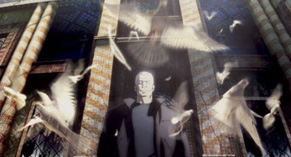 onal anime science-fiction future, the similarities between Oshii’s film and standard Japanese animation ends here. Like the film before it, Innocence is obsessed with the binary separation between man and machine, and more specifically the issues raised in the future when humans, enhanced by cybernetic upgrades, cross the line between man and machine and refer to the traces of a soul in a mechanical body as a “ghost.” The ghost in Oshii’s own machine is often difficult to find. Like the cyborgs that inhabit the film, Innocence raises astute, highly intelligent questions about the man/machine binary, and like those cyborgs the film asks whether something as inorganic as a machine or a enervated, constructed film can bare evidence of a soul.
onal anime science-fiction future, the similarities between Oshii’s film and standard Japanese animation ends here. Like the film before it, Innocence is obsessed with the binary separation between man and machine, and more specifically the issues raised in the future when humans, enhanced by cybernetic upgrades, cross the line between man and machine and refer to the traces of a soul in a mechanical body as a “ghost.” The ghost in Oshii’s own machine is often difficult to find. Like the cyborgs that inhabit the film, Innocence raises astute, highly intelligent questions about the man/machine binary, and like those cyborgs the film asks whether something as inorganic as a machine or a enervated, constructed film can bare evidence of a soul.
The stoic Section 9 investigator Batou returns in the sequel sans Major Kusanagi -the cybernetic female heroine of the original who transcends the limitations of her flesh and robotics-and follows the familiar detective path of banal crime that inevitably unfolds into a questioning of technological and religious philosophy. In the first film the criminal was a rogue program that drew attention to itself through renegade hacking in order to merge with an entity containing a ghost. In the sequel the crimes are only slightly less dry-various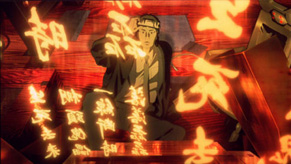 dolls of the same model and make, illegally created and used for sexual activities, have recently assumed ghosts of their own, thereby gaining self-awareness and the ability to override robot ethical codes and harm humans.
dolls of the same model and make, illegally created and used for sexual activities, have recently assumed ghosts of their own, thereby gaining self-awareness and the ability to override robot ethical codes and harm humans.
With an overwhelming consistency, and with a technique that deepens the films meaning at the same time it impairs the film’s entertainment and narrative value, Oshii attacks the simplicity of the human-machine separation, a binary system that reveals endless complexities and convolutions inherent in Innocence itself. Engaging the film is not so much engaging a story, rather it is an exploration of the themes Oshii inelegantly hardwires into the narrative.
The most startling of this engagement of human/machine distortion is within the style of the film. Like many current anime works, Oshii uses both traditional two-dimensional animation and compliments (and sometimes supplements) its limitations with three-dimensional computer animation. In most films the result is tacky and obvious; the two techniques generally do not blend together 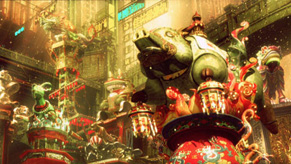 well and produce an alienating effect. It is no different in Innocence, but the ungainly visual look is one of a myriad of visual cues Oshii provides to reveal the mystery of his themes. For this aspect, the traditional animation, though less realistic looking, has an organic and fluid feel, while the newer computer animation has a inert, artificial lifelessness that convolutes the fact that its very dimensionality should make it appear more natural. This is only one example in a film that contains what seems a near endless amount of engagements with the blurring between man and machine. Others pop up with greater frequency than actual plot elements: the artificial reality of hacked human memory vs. what one presumes are organic perceptions (and the implications of this in movie watching); the idea of a robot keeping a pet and being loved by it; the possibility that an infinitely flexible and omniscient free-willed information based entity could function as a god, etc., etc., and so on.
well and produce an alienating effect. It is no different in Innocence, but the ungainly visual look is one of a myriad of visual cues Oshii provides to reveal the mystery of his themes. For this aspect, the traditional animation, though less realistic looking, has an organic and fluid feel, while the newer computer animation has a inert, artificial lifelessness that convolutes the fact that its very dimensionality should make it appear more natural. This is only one example in a film that contains what seems a near endless amount of engagements with the blurring between man and machine. Others pop up with greater frequency than actual plot elements: the artificial reality of hacked human memory vs. what one presumes are organic perceptions (and the implications of this in movie watching); the idea of a robot keeping a pet and being loved by it; the possibility that an infinitely flexible and omniscient free-willed information based entity could function as a god, etc., etc., and so on.
As Batou and his human partner Togusa get more tangled up in the investigation to find the source of the dolls’ souls, the film takes on a near-lifeless, brooding philosophic atmosphere. The stillness of the film comes as a constant surprise; Oshii takes 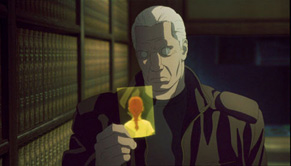 many moments for deadpan reactions and silent inaction that belays any sense of the characters’ contemplations. Often, little effort is exerted to elaborating the mise-en-scene. Instead, the staid drama of the film once again fuels its thematics. The fact that the human and emotive Togusa, a family man with a wife and a daughter, wants no part of the philosophic questions the investigation turns up is all the more confounding when Batou, an inert expressionless being who is more machine than man, actively seeks answers to the questions of life. Through a unique kind of thematic loophole Oshii has found a subject for his film that contains within the abilities to conquer criticism about the film itself.
many moments for deadpan reactions and silent inaction that belays any sense of the characters’ contemplations. Often, little effort is exerted to elaborating the mise-en-scene. Instead, the staid drama of the film once again fuels its thematics. The fact that the human and emotive Togusa, a family man with a wife and a daughter, wants no part of the philosophic questions the investigation turns up is all the more confounding when Batou, an inert expressionless being who is more machine than man, actively seeks answers to the questions of life. Through a unique kind of thematic loophole Oshii has found a subject for his film that contains within the abilities to conquer criticism about the film itself.
That the film offers a hero with no charismatic power, for whom no effort is put into to develop emotions, facial expressions, or any kind of empathy, Oshii invests the soul of a lost philosopher (as well as a dog lover). Likewise exists a world of the future-populated only by white-collar policemen, faceless criminals, soulless robots, and dreamy pseudo- philosophers-that has no depth of realism, little humanity, and barely an organic presence. The remarkable non-narrative montage of the organically decaying Asian metropolis in Ghost in the Shell spoke more for humanity than Innocence’s golden computer-generated Asian festival, replete with artificial gloss and color. This is a sad, dreary world that has been wrought by confusing man and machine, and the film itself is just as grave and inert in its combinations-2d/3d; anime conventions and that of the art film; sci-fi thriller and sprawling intellectual musing. And in this confusion lies both its depth and its near-tedium.
The sheer intellectual richness and complexity of Innocence is overwhelming, and all the more so because i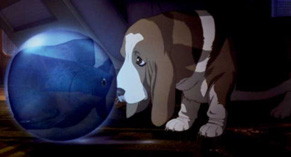 t is so accessible and displayed on a surface level. Something as conventional as using “futuristic” graphical overlays, graphs, models, and representations on the screen becomes yet another layer of mechanical representation of an organic reality. A gun battle at the beginning of the film has Batou mowing down human yakuza, and at the end of the film he guns down an equal amount of lifeless dolls. Do these dolls have souls? Does it make a difference for Batou? For the film viewer? The doll motif is a key one for Oshii, who ties the dolls narrative of Batou’s investigation into questioning the rearing of children, the keeping of pets, and the issues wrought in the first film how DNA might just be a complicated data program bent on re-creation instead of mere copying.
t is so accessible and displayed on a surface level. Something as conventional as using “futuristic” graphical overlays, graphs, models, and representations on the screen becomes yet another layer of mechanical representation of an organic reality. A gun battle at the beginning of the film has Batou mowing down human yakuza, and at the end of the film he guns down an equal amount of lifeless dolls. Do these dolls have souls? Does it make a difference for Batou? For the film viewer? The doll motif is a key one for Oshii, who ties the dolls narrative of Batou’s investigation into questioning the rearing of children, the keeping of pets, and the issues wrought in the first film how DNA might just be a complicated data program bent on re-creation instead of mere copying.
Under the weight of so many themes wrought of a simple binary, Innocence’s endorsement of humanity at the end may seem like a dim hope that life may return to the film. That this life seems purposeless and continually sucked out of Innocence is ironic as the film so thoroughly engages questions about the nature of life itself. How can such a cold, unengaging film ask such questions about the potential of the soul? It is the film’s mystery; its greatest achievement and its most clear failure.


0 Comments:
Post a Comment
Subscribe to Post Comments [Atom]
<< Home